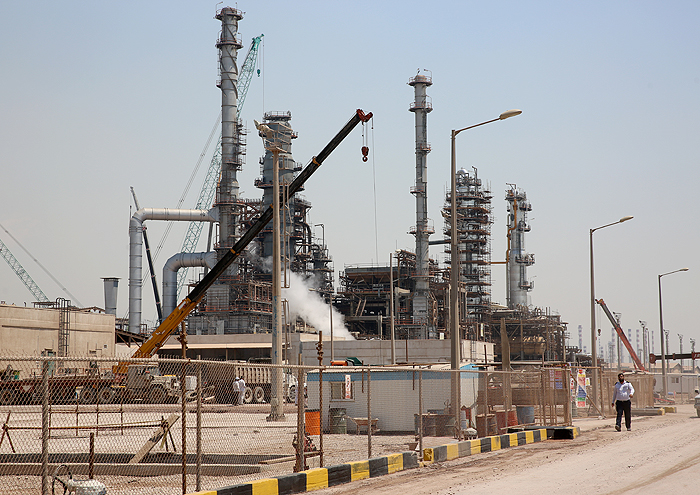Commonly known as Persian Gulf Star refinery, in allusion to the name of its constructor Persian Gulf Star Oil Company, the refinery is being developed in three phases. With a capacity of processing 360,000 b/d of gas condensate for an output of 26 million liters a day of gasoline, the facility is the largest gas condensate refinery in Iran.
Phase 1 of this refinery was inaugurated during the first term in office of President Hassan Rouhani. Phase 2 of the facility is expected to become operational in coming months.
Ali-Reza Sadeq-Abadi, CEO of National Iranian Oil Refining and Distribution Company (NIORDC), told a press conference the Euro-5 grade gasoline production at the refinery had reached 22 million liters a day, from 12 ml/d produced until recently.
He said that Phase 1 of the refinery started producing 11 ml/d of gasoline, which rose to 16 ml/d and now had hit 22 ml/d.
Sadeq-Abadi said domestically manufactured catalysts had been used in Phases 1 and 2 of the refinery. "Of course Phase 2 catalyst had been upgraded. The sulfur content of Euro-5 gasoline must be below 10 ppm and in this refinery it is even below 0.5," he added.
Sadeq-Abadi said President Rouhani had given green light for the allocation of €260 million budget for the completion of the refinery.
"€120 million has been provided from the sales of refined products while €120 million will be earmarked from the National Development Fund of Iran (NDFI)," he said, adding that manufacturers and contractors had been remunerated.
32ml/d Euro-4 Gasoline
Sadeq-Abadi also referred to Euro-4 gasoline production at the Arak, Tabriz, Isfahan and Abadan oil refineries, saying: "The refineries are supplying 32 ml/d of Euro-4 gasoline. Of course, the average daily production stood at 28 ml/d in the Iranian calendar year 1396 (March 2017-March 2018)."
He added that Lavan refinery's 2.5 ml/d Euro-4 gasoline production capacity would rise to 3 ml/d by September, while Abadan refinery's Euro-4 gasoline output would reach 9 to 10 ml/d, 2 ml/d of which would be green gasoline lacking any benzene or aromatics.
Regarding Euro-4 gasoil production, Sadeq-Abadi said: "Euro-4 gasoil production at Tehran, Arak, Isfahan and Lavan refineries stood at 28 ml/d with the average for the Iranian calendar year 1396 having been at 26 ml/d."
He said that in the new Iranian calendar year, gasoil production would increase to 105 or 110 ml/d, 70 ml/d of which would be Euro-4 grade.
Average gasoline production was at 60 ml/d during the first quarter of the Iranian calendar year 1396, which reached 78 ml/d by the end of that year. Bandar Abbas condensate refinery accounted for 9 ml/d.
Quantity, Quality Upgrade
Sadeq-Abadi said Bandar Abbas condensate refinery's production totaled 36 ml/d.
"Our perspective for gasoline production up to the end of the calendar year 1397 would be 105 ml/d, 87 ml/d of which would be Euro-4 and Euro-5 grade," he added, noting that it would represent a big jump in both quantity and quality.
Sadeq-Abadi said that all refineries would be overhauled in the current Iranian calendar year. However, he added, the overhaul schedule would be such that their average output would be least affected.
Regarding fuel distribution, he said: "65% of fuel distribution rests with Iran Oil Pipeline and Telecommunications Company (IOPTC) and 35% with National Iranian Oil Products Distribution Company (NIOPDC)."
Fuel Mix Diversity
Sadeq-Abadi said gasoline production was forecast to grow 9% in the current calendar year.
"Apart from gasoline, gasoil production is set to grow about 7% this [calendar] year. Therefore, we cannot remain indifferent vis-à-vis fuel consumption," he added.
Noting that a good jump had been seen in the gasoline production capacity, Sadeq-Abadi said: "In order to reduce gasoline consumption, certain arrangements need to be made in car manufacturing and their fuel consumption."
"To that effect, we can study diversification of fuel mix and increase the share of CNG (compressed natural gas) in this mix," he added.
Average gasoline consumption in the first month of the current calendar year (started on March 21) was 11% up year-on-year, said Sadeq-Abadi, adding that gasoline consumption had grown 10% in the same period year-on-year.
Sadeq-Abadi said imported gasoline had been partly stored and partly consumed.
"Average gasoline imports during the first half of last calendar year was 13 ml/d, which was down to 5 ml/d in the last quarter of that year," he added. "Gasoline imports are estimated at about $2 billion," said Sadeq-Abadi, adding that the International Affairs Directorate of the National Iranian Oil Company (NIOC) was handling gasoline imports.
Sadeq-Abadi also touched on the Siraf refining project, saying: "The L/C for four refineries has taken effect and three refineries have yet to be finalized. We are in talks with four companies."
Iran Sanctions-Era Refining Project
Sadeq-Abadi also referred to the impact of economic sanctions on petroleum industry development, saying: "We have used the most sophisticated equipment in the construction of the Persian Gulf Star refinery and this equipment is becoming operational. No specific equipment is planned to be purchased."
He said that during the years of sanctions, Iran developed some potential.
"Persian Gulf Star refinery was launched under sanctions. That proves the capability of Iranian manufacturers," he added.
Sadeq-Abadi highlighted Iran's $30 billion refining industry market, saying: "Sanctions will not just inflict losses on Iran's petroleum industry; international companies will also suffer losses due to losing this market. Iran is a big market and it could not be easily ignored."
He said that the refining industry needed to provide its financial resources in hard currency because Iran's legal tender would not be attractive for this sector.
Courtesy of Iran Petroleum


Your Comment